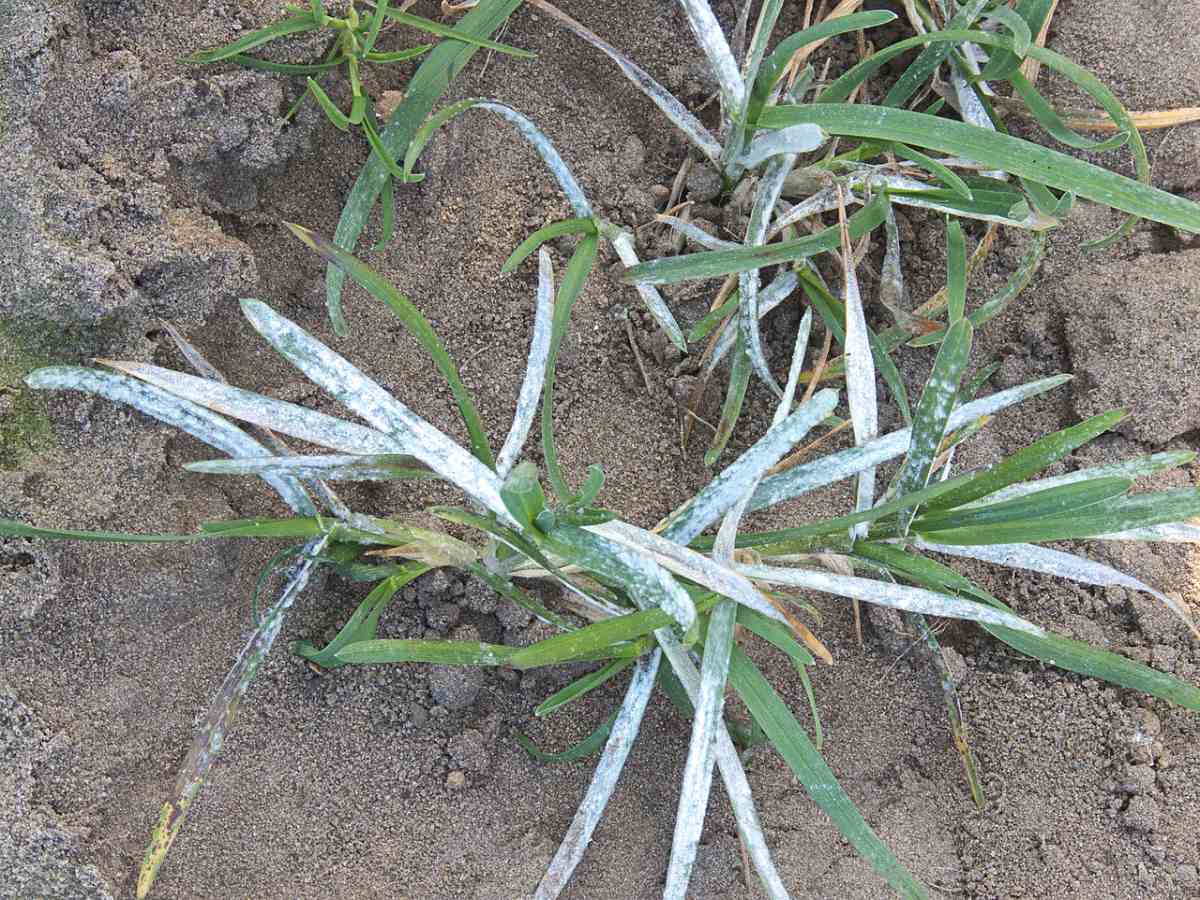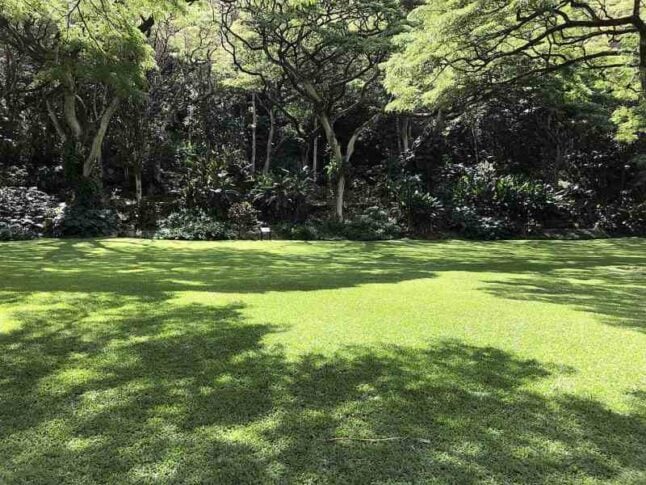
When we look outside at our lawn, we expect—or rather hope—to see healthy, green grass. If you quickly peek out the window to find powdery patches of white smattering the yard, it’s natural to get worried. What you’re probably seeing is a lawn disease called powdery mildew, which is caused by fungi.
Before you get too anxious, know that powdery mildew is fairly innocuous and easily treatable. Our guide will teach you how to treat powdery mildew on your lawn so you can have your pristine, green grass back in no time!
What is Powdery Mildew?
Powdery mildew is the popular name for a group of plant diseases that display similar symptoms and are caused by closely related types of fungi. They’re typically recognized by their characteristic white, powdery blotches on infected plants’ stems, leaf surfaces, and fruits. The patches are an accumulation of white—and sometimes gray—fungal spores.
Many plants in your landscape are susceptible to powdery mildew: vegetables, fruits, flowers, woody ornamentals, trees, weeds, and grasses. In this article, we are focusing on how to treat powdery mildew in lawns.
While the sight of the white powder across your grass may be concerning, the good news is that the different species of fungi responsible for the disease are host-specific. This means the fungi usually don’t spread between different types of plants.
So, the powdery mildew in your turfgrass won’t bother your cucumbers, begonias, or tomatoes. If, by chance, you’re growing cereal grains like oats or barley, you’ll want to watch them for signs of infection.
Identifying Powdery Mildew in Turfgrass
Powdery mildew is relatively easy to spot and identify in your grass. If it looks like someone dusted flour or cornstarch across your yard, you’re looking at the tell-tale signs of powdery mildew.
If you want to investigate further, here are other common symptoms to watch for:
- Small, white spore masses develop as circles on the infected leaves
- White masses start enlarging, covering the entire blade
- Tiny black spots known as fruiting bodies develop inside the powdery patches
- Severely infected grass starts turning yellow
Treating Powdery Mildew on Your Lawn
How you tackle powdery mildew on your lawn ultimately comes down to a personal decision. Personally, I like to take a less invasive approach initially instead of turning directly to fungicides.
Changing the cultural environment is the most harmless way to treat powdery mildew, but it does require a few changes to your lawn care practices, including:
- Trim or prune plants that are blocking sunlight from reaching your grass.
- Remove or thin out thick plants that contribute to poor air circulation around the infected areas.
- Water in the early morning, so excess humidity is burnt off quickly, and shady areas don’t stay wet longer than necessary.
- Scale back on fertilizing to avoid heavy nitrogen applications, which can contribute to fungus growth.
That said, if the appearance of powdery mildew-infected turf gives you the heebie-jeebies or is just wholly intolerable, you can apply fungicides to get it under control quicker. According to Purdue Extension, DMI class fungicides (metconazole, myclobutanil, propiconazole, tebuconazole, triadimefon, and triticonazole) are best for powdery mildew.
Find the best lawn fungicides for powdery mildew online:
- Fertilome Liquid Systemic Fungicide (active ingredient: propiconazole)
- Gravex Fungicide by Atticus (active ingredient: myclobutanil)
- BioAdvanced Disease Control (active ingredient: tebuconazole)
If you’re looking for a natural powdery mildew treatment, baking soda and neem oil are great options. Here’s how to use these natural remedies:
- My preferred treatment method: Mix one tablespoon of baking soda (or potassium bicarbonate–which is not the same thing!) per gallon of water, adding half a teaspoon of liquid soap (use Castile soap for an all-natural concoction). Put the mixture in your sprayer or a spray bottle and coat the tops and undersides of all infected grass blades.
- Neem oil is an organic fungicide suitable for various plants, from turfgrass to succulents, zinnias, zucchini, pumpkins, lilacs, etc. You can purchase it in a ready-to-use spray bottle and spray it on the tops and undersides of infected grass blades.
Find neem oil sprays online:
- Natria Ready-to-Use Neem Oil Spray
- Bonide Captain Jack’s Ready-to-Use Neem Oil Spray
- Harris Ready-to-Use Neem Oil Spray
Preventing Powdery Mildew in Your Grass
I’m a huge proponent of implementing practices that prevent problems in your plants versus having to address concerns when they arise. That old “an ounce of prevention is worth a pound of cure” chestnut.
As soon as you get your grass nice and green again, you’ll want to follow these preventative steps to keep the powdery mildew out of your yard for good.
- Reseed shady spots using a powdery mildew-resistant Kentucky bluegrass cultivar or shade-tolerant fine fescue.
- Maintain recommended watering techniques, including watering the lawn early in the morning and only when your grass needs it (overwatering encourages fungal growth). Learn more about proper watering in our lawn irrigation guide.
- Make sure you’re mowing at the proper height for your grass type, and check out these other lawn mowing tips.
- Test your soil and develop a fertilizer program suitable for the soil fertility and grass type.
- Ensure proper spacing for good air circulation and sunlight penetration when planting new plants.
- Apply horticultural oils such as neem or jojoba to susceptible plants. They can prevent powdery mildew in addition to treating it.
What Causes Powdery Mildew in Lawns?

First off, the fungus that causes powdery mildew in turfgrass is Blumeria graminis. It was formerly called Erysiphe graminis, but in 1975, scientists moved it to its own genus because of slight differences in the fungal structures.
Blumeria graminis doesn’t happen randomly or show up willy-nilly. To infect your backyard, it needs specific environmental conditions:
- Shade
- Lack of air circulation
- High humidity (not necessarily wet foliage)
- Air temperatures between 60 and 70°F
- Too much nitrogen fertilizer
How Does Powdery Mildew Spread?
Powdery mildew has a unique way of surviving through the colder months. It needs living tissue to grow and reproduce, so it had to learn to adapt through winter.
It overwinters in living grass tissue in areas where the temperatures don’t drop too cold. But in areas where the grass goes dormant in winter, it develops specialized survival structures known as chasmothecia, allowing the spores to hang out within the thatch later.
When spring rolls around and temperatures reach 60°F, the chasmothecia rupture and release their spores, causing infection. The wind then distributes and spreads the Blumeria graminis to healthy grasses.
Contrary to popular belief, powdery mildew does not spread via rain or water droplets.
Are Some Grasses More Prone to Powdery Mildew?
Unfortunately, yes. Some grasses are highly susceptible to powdery mildew. Kentucky bluegrass, Bermudagrass, redtop, and Zoysiagrass are the worst turfgrasses for the disease, especially when grown in shaded conditions. It will occasionally infect the different types of fescues, but they are generally more resistant.
Will Powdery Mildew Kill My Grass?
Powdery mildew is not a drastic turfgrass disease and generally does not kill turf like some other fungi (such as dollar spot, pythium blight, or brown patch). However, that doesn’t mean you should ignore the problem if you’re in the cooler part of the year.
When conditions are right, paying no heed to powdery mildew for too long severely weakens your turf. The struggling turf can succumb to other stressors, like more serious diseases or insect pests, which can kill the grass.
FAQ About Powdery Mildew
No. There’s no need to keep your pets or kids from playing in the yard once you discover powdery mildew in the grass. It will not harm either and doesn’t threaten your shrubs or roses. This fungus only bothers grass.
Powdery mildew isn’t as threatening or damaging as other lawn diseases and will go away naturally once your grass goes dormant for the winter or if you follow good lawn care practices.
Powdery mildew thrives in humid climates and shady areas, but surprisingly, rain washes the spores off the grass blades (compared to some fungal diseases transferred by rain droplets). For this reason, the strain infecting your lawn prefers dry weather with little rain.
Need Professional Help?
When you notice a turf disease in your lawn, it’s easy to immediately think you need to hit it hard and quickly with fungicides. Thankfully, in the case of powdery mildew, your first line of defense is to implement better cultural practices. But sometimes, finding the extra time in your schedule to get rid of powdery mildew seems impossible.
If you’re short on time and don’t think you can tackle the problem, hire a LawnStarter pro near you to handle the job. Not only can they help control powdery mildew, but they can also help prevent future outbreaks with routine lawn maintenance. Instead of spending your free time keeping a fungus in check, you can spend it doing something more fun – like rolling in the grass instead of working in it!
Main Photo Credit: Powdery Mildew on Kentucky Bluegrass / Rasbak / Wikimedia Commons / CC BY-SA 3.0